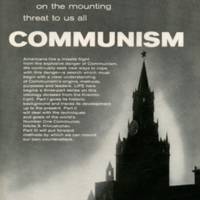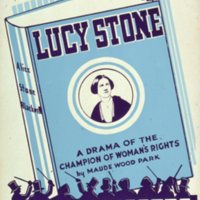Browse Exhibits (2 total)
Looking Over Our Shoulder: The Cold War in American Culture

On March 5, 1946 former British Prime Minister Winston Churchill warned an American audience at Westminster College in Fulton, Missouri that “an iron curtain has descended across the continent” of Europe. He insisted to his audience, which included the U.S. President, Harry S. Truman, that the Soviet domination of Eastern Europe was not only a threat to Europe itself, but a severe threat to the entire free world. He encouraged the United States and Western Europe to not consider the Soviet Union an ally, but rather a dangerous opponent because the goal of the Soviet system was to spread Communism to all countries in the world. In its brief history as a nation to that point, Churchill noted, the Soviet Union had shown the world that it was not averse to advancing this goal by force, and the U.S. and other western nations should be wary of them. They should not form alliances with them or share critical technologies, particularly the Atomic Bomb.
This sobering speech is considered one of the opening salvos of the Cold War, a forty-five-year rivalry between the United States and western democracies on one side and the Soviet Union and its orbit of communist allies on the other. Life in America went on after Churchill’s dire warning, but many elements of it were directly influenced by the notion that communists were lurking everywhere and ready to infiltrate, attack, and destroy our country and our freedoms.
While the two major antagonists never engaged in actual war, the U.S. and its allies participated in a series of smaller conflicts with Soviet client states, ending with over 80,000 American troops killed in Korea and Vietnam. Outside of any actual fighting, there existed a war of propaganda on the world stage over which political system was better. Each side tried to show its opponent, as well as the rest of the world, whose people had a better standard of living, which side was more cultured, and who was better on the athletic field, let alone the battlefield. The two sides also vied for superiority in technology, particularly the effort to develop more powerful rockets - potentially, to deliver nuclear weapons. A byproduct of this competition was the race to put satellites and humans into space, using the very same rocket technology.
Closer to home, tensions between the U.S. and the Soviet Union affected how Americans lived their everyday lives and interacted with their fellow citizens. The Soviet Union’s successful testing of an atomic bomb in 1949 drove Americans to fear that they might use it at some point against the United States. Espionage became a major preoccupation of politicians and citizens. Fear of spies and saboteurs, both foreign and domestic, was very real. Alarmists believed that Americans who were against war or for civil rights were helping to advance the communist agenda. Fighting Communism required each one of us to be a patriot in our thoughts and actions. This could be demonstrated by simply associating with the “right” people or building a bomb shelter in one’s backyard.
In this exhibit, the Special Collections Research Center staff have selected examples from our collections to illustrate the concerns about the spread of Communism, the threat of atomic warfare, the Space Race, and other aspects of American life during the Cold War through manuscripts, photographs, publications, material culture, and other items. SCRC holds these and other collections related to the Cold War for use by students, faculty, researchers, and others for research or instructional use. For additional information, please contact us at speccoll@gmu.edu.
The 19th Amendment in the 20th Century

For Americans today the right to vote regardless of sex is a basic and indisputable principle. The 19th Amendment to the United States Constitution, ratified in August of 1920, affirms this belief and gives it legal authority. And while ratification of the 19th Amendment represents a major victory in the centuries-old struggle for equality for women, equal opportunity has remained an objective for which many have fought and continue to fight.
Exhibit items: The 19th Amendment in the 20th Century
